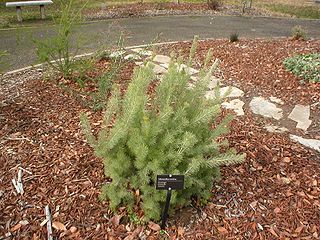
Adenanthos is a genus of Australian native shrubs in the flowering plant family Proteaceae. Variable in habit and leaf shape, it is the only genus in the family where solitary flowers are the norm. It was discovered in 1791, and formally published by Jacques Labillardière in 1805. The type species is Adenanthos cuneatus, and 33 species are recognised. The genus is placed in subfamily Proteoideae, and is held to be most closely related to several South African genera.

Adenanthos sericeus, commonly known as woolly bush, is a shrub native to the south coast of Western Australia. It has bright red but small and obscure flowers, and very soft, deeply divided, hairy leaves.
Adenanthos terminalis, commonly known as gland flower, yellow gland flower or adenanthos, is a one metre tall shrub in the family Proteaceae. It is found in south eastern regions of Australia, in the states of South Australia and Victoria, and is the most widespread of the two Adenanthos species occurring outside of Western Australia.

Adenanthos cuneatus, also known as coastal jugflower, flame bush, bridle bush and sweat bush, is a shrub of the family Proteaceae, native to the south coast of Western Australia. The French naturalist Jacques Labillardière originally described it in 1805. Within the genus Adenanthos, it lies in the section Adenanthos and is most closely related to A. stictus. A. cuneatus has hybridized with four other species of Adenanthos. Growing to 2 m high and wide, it is erect to prostrate in habit, with wedge-shaped lobed leaves covered in fine silvery hair. The single red flowers are insignificant, and appear all year, though especially in late spring. The reddish new growth occurs over the summer.

Adenanthos macropodianus, commonly known as gland flower, or Kangaroo Island gland flower, is a species of shrub in the family Proteaceae. It is endemic to Kangaroo Island in South Australia. First published as a variety of A. sericeus in 1870, it was promoted to species rank in 1978.
Adenanthos cacomorphus is a small shrub in the family Proteaceae. It is found in southwest Western Australia.

Adenanthos detmoldii, commonly known as Scott River jugflower or yellow jugflower, is a species of shrub in the family Proteaceae. It is endemic to the south-west of Western Australia.
Adenanthos ileticos is a species of shrub in the family Proteaceae. It has roughly triangular, lobed leaves, and pale pink-red and cream, inconspicuous flowers. A rare species, it is known only from a single location in the south-west of Western Australia. It was discovered in 1968, and immediately brought into cultivation, but it would not be formally published and named until a decade later.

Adenanthos barbiger, the hairy jugflower or hairy glandflower, is a species of shrub in the family Proteaceae. It is endemic to the south-west of Western Australia. It usually grows to 1 metre high, and has bright red flowers that appear mostly between August and December. The species was first formally described in 1839 by English botanist John Lindley in A sketch of the vegetation of the Swan River colony.

Adenanthos meisneri, commonly known as prostrate woollybush, is a species of shrub in the family Proteaceae. It is endemic to the south-west of Western Australia.

Adenanthos pungens, the spiky adenanthos, is a species of shrub in the family Proteaceae. It is endemic to the south-west of Western Australia.

Adenanthos × cunninghamii, commonly known as woollybush, Albany woollybush or prostrate woollybush, is a hybrid shrub in the family Proteaceae. It is endemic to the south-west of Western Australia.
Adenanthos dobagii, commonly known as Fitzgerald woollybush, is a shrub in the family Proteaceae. It grows to a mere 50 cm high, with crowded small silvery leaves and insignificant pink or cream flowers. It occurs only in southwestern Australia, where it is found in Fitzgerald River National Park on the south coast.
Adenanthos eyrei is a species of shrub in the family Proteaceae. Restricted to a single cliff-top dune system on the remote south coast of Western Australia, it is listed as rare and endangered. It was discovered by E. Charles Nelson in 1973, and formally described and named in 1978.

Adenanthos glabrescens is a species of small shrub endemic to the Ravensthorpe area in southwest Western Australia. First published in 1978, there are two subspecies.
Adenanthos labillardierei is a species of erect shrub endemic to the slopes of the Barren Ranges in the Fitzgerald River National Park in southwest Western Australia.

Adenanthos oreophilus, commonly known as woollybush, is a species of tall shrub endemic to southwest Western Australia. It is closely related to the better known A. sericeus, and was only classified as a species distinct from the latter in 1978 by Irish botanist E. Charles Nelson.
Adenanthos filifolius is a species of erect shrub endemic to southwest Western Australia. It was first described by George Bentham in 1870.

Adenanthos sericeus subsp. sericeus, commonly known as coastal woollybush, is a shrub native to the south coast of Western Australia. It has bright red but small and obscure flowers, and very soft, deeply divided, hairy leaves. It is the western subspecies of Adenanthos sericeus, occurring mostly in the vicinity of King George Sound.












